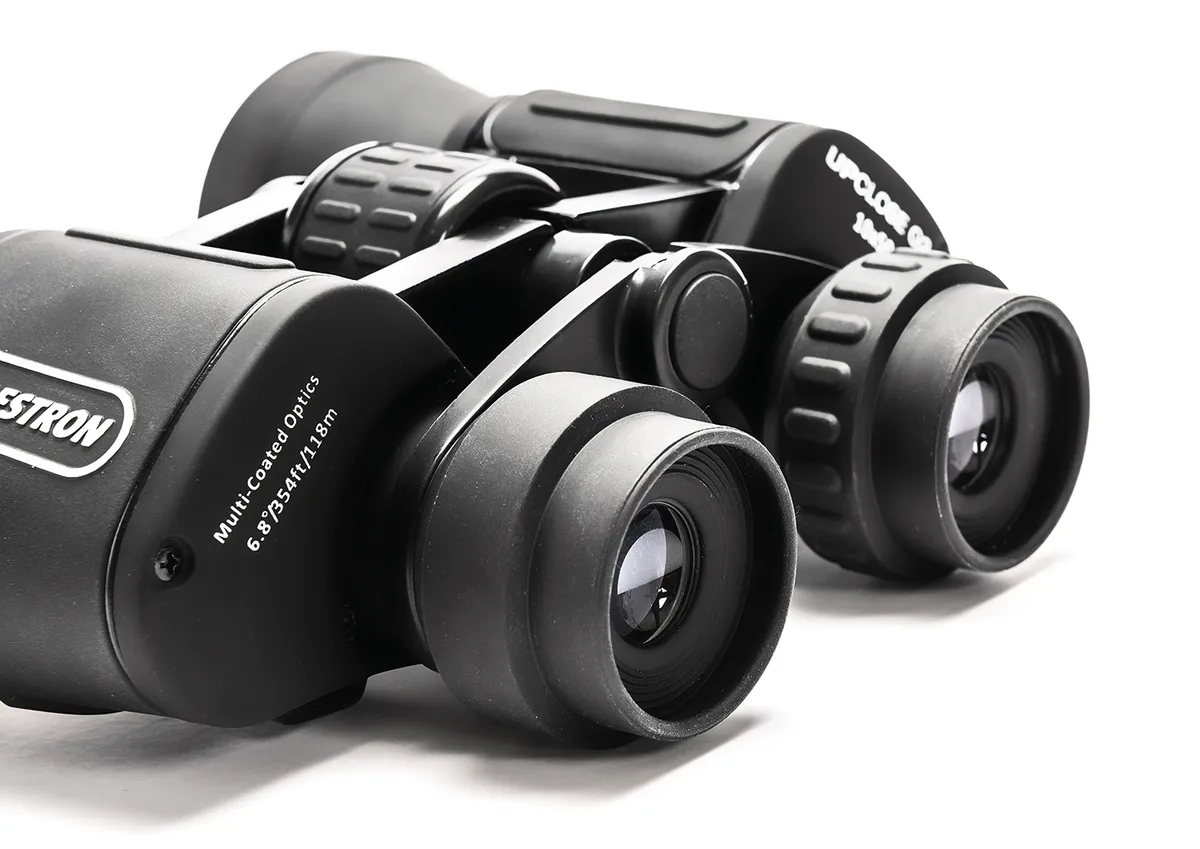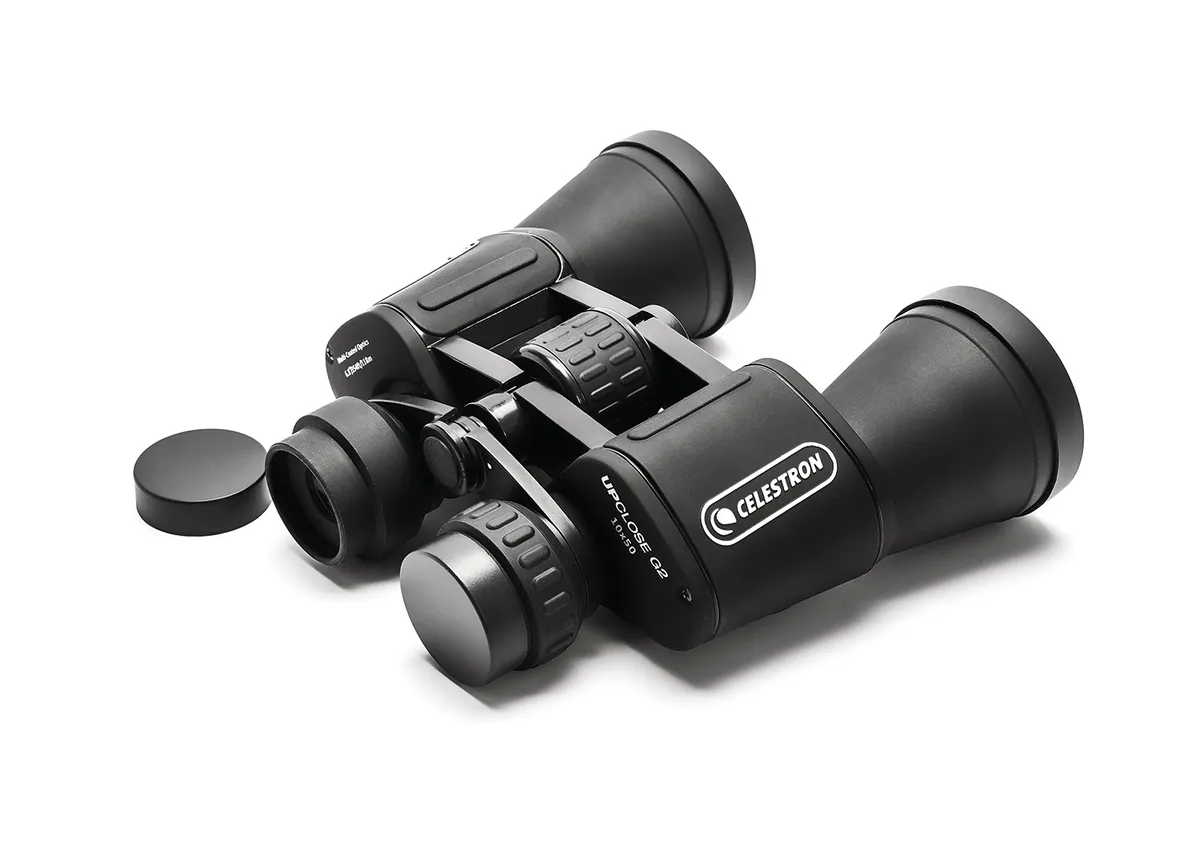An inexpensive pair of 10x50 binoculars can serve as an ideal entry-level instrument, being the maximum aperture and magnification that you can easily hold by hand. Celestron’s UpClose G2 is a lightweight candidate for this position.
The binoculars are supplied with a soft, lightly padded case, caps for all lenses, a neck-strap and a microfibre cleaning cloth.
The objective lens caps are too loose and fall off under gravity, so it would be best if you keep those in the case and use them only to keep debris off the lenses when the binoculars are stored or transported.
When held up to the light, we could see that each of the exit pupils has four tiny, light-grey segments on the periphery. This is due to the low refractive index of the glass used for the prisms.
This results in a slight dimming of the edge of the field of view, so it is necessary to make sure that you keep target objects in the brighter centre of the field.
The exit pupils of a pair of 10x50s should have a diameter of 5mm, but these appeared to be smaller than that.
On investigation we found that, in common with many budget binoculars, although the physical aperture is 50mm, the
light path is internally stopped, in this case to an effective aperture of 40mm.
The aim of this is to reduce optical aberrations to deliver crisper if somewhat fainter images.
These binoculars appear on our list of the best binoculars for astronomy and stargazing

Double troubles
We focused the binoculars and found that the image was crisp in the middle of the field of view.
The images from each side were separate, giving a double-image that was not easily merged into a single one. This shows that collimation was outside acceptable tolerances.
Unfortunately, this is fairly common in budget binoculars and, should you get one that is similarly afflicted, you should have it replaced under warranty.
We also found that the 12mm eye relief is insufficient to allow the whole field of view to be visible with spectacles, even with the rubber eyecups folded down.
There is severe pincushion distortion affecting the outer 50 per cent of the field of view. This makes straight lines appear to bow inwards and distorts the relative positions of some stars in the field of view.
Control of false colour was quite good on axis, but the last quarter Moon showed colour when the limb was even slightly off axis.
However, the bright star Vega in Lyra only showed false colour when it was near the edge of the field of view.
These binoculars are specified as being ‘multicoated’, which usually means that the outer surfaces of the objective lenses and eyepieces are coated, but the prisms are not.
This was confirmed by spurious ghost reflections when the Moon was both in and just outside the field of view.
We checked the colour rendition in the region of Herschel’s Garnet Star (Mu Cephei), which stood out as distinctly orange-red and contrasted well with the brilliant white Alderamin (Alpha Cephei), orangey-yellow Zeta Cephei and hot blue Lambda Cephei.

With the binoculars mounted, we could split double star Albireo in Cygnus into its two colour-contrasted components (separated by 34 arcseconds) in the central third of the field of view.
Nearby in Vulpecula, the Coathanger asterism (Collinder 399) was nicely framed and, panning to the east, we could see the Dumbbell Nebula (M27) as a tiny, slightly elongated cloud.
The Andromeda Galaxy appeared as an oval glow, brightest in the middle, and extending faintly across nearly one third of the field of view.
In the open cluster NGC 752, also in Andromeda, we were able to resolve eight stars against the granular glimmer of the other 70 or so.
Despite its optical shortcomings, we found this binocular to be very comfortable to use; it is light and well-balanced, and the rubber eyecups are comfortable.
It is best suited to casual users who want a pair of relatively inexpensive binoculars for occasional astronomical use.
Smooth and easy to use focusing
You will find it much more pleasurable to use binoculars that are easy to adjust and focus, especially if you need to do so wearing thick winter gloves.
The UpClose G2 10x50s meet these criteria: the hinge, centre-focus and right-eyepiece dioptre focus all operate smoothly throughout their ranges and fall into the sweet spot between being too stiff and too slack.
The wide centre-focus wheel is ribbed, making it easy to adjust precisely with or without gloves.
It rotates one and a quarter times between the near and far extremes of focus, meaning that large movements of the wheel correspond to only small shifts.
This makes it much easier to attain a precise focus than if it were to change appreciably for only a small turn of the wheel.
The right-eyepiece dioptre adjuster is a large knurled wheel that is also easy to adjust with gloved hands.
The hinge is stiffer than both the focuser and the dioptre adjustment, so once you have set the interpupillary distance you are unlikely to inadvertently alter it while focusing.

Eyepiece covers
A significant source of debris on eyepieces when binoculars are hung around your neck is descending pollen and dust. The eyepiece covers are particularly well fitting and unlikely to get knocked off, reducing the frequency with which you’ll need to clean the eyepieces.
‘Beyond infinity’ focus wheel
When you refocus from a near object to a distant object, you will find that there is still some focal range remaining. This will be of interest to shortsighted stargazers, who will be able to observe without corrective spectacles.
Small eyepieces
The eyecups are only 37mm diameter, which is small for modern 10x50s, but it means that the minimum interpupillary distance of 56mm can be obtained without the eyecups squeezing the bridge of your nose. This makes these binoculars a realistic option for astronomers with small faces.
Rubber armour
The rubber armour is sufficient to protect against the minor knocks and bumps of everyday use. There are also thumb indents and finger ridges on the prism housings; the indents have more texture than the rest of the rubber armour, and help to give you a secure hold without having to grip tightly.
Tripod bush
Although the binoculars are light and easy to hold by hand, you will be able to see fainter objects and split closer double stars if you mount them. On the end of the hinge is a metal bush threaded with a standard ¼-inch Whitworth thread for a tripod adaptor L-bracket.
Vital stats
- Price £50
- Optics Multicoated
- Aperture 50mm
- Magnification 10x
- Exit pupil 5mm
- Prisms BK7
- Angular field of view 6.8°
- Focusing Centre focus
- Eye relief 12mm
- Interpupillary distance 56-72mm
- Weight 765g
- Supplier Celestron UK
- www.celestron.uk.com
- Tel 01525 852696
